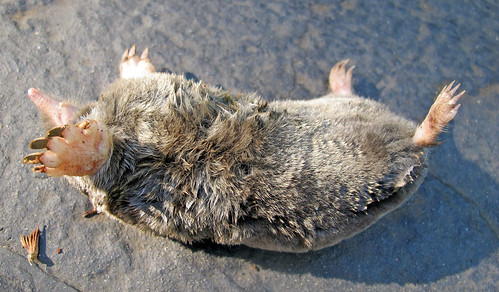
Broad-footed Mole (Photo credit: K Schneider)
Broad Footed Mole
Scapanus latimanus
The Broad Footed Mole is known to be a territorial mole species and would do everything to defend their home range. They are known to patrol the tunnel systems they keep, confronting any other animal that enter their burrows. This mole behavior becomes more apparent when a female mole becomes pregnant or there are young moles which they need to care, feed and protect.
They are also known as 'The Californian Mole' and can be identified by their fur. Their body's coated with brown grey fur at the upper portion, with grayish silver in their underside part. Their short tail has a small hair tuft on its tip. Their average length is around 5.5 inches to 5.75 inches, with tail of around 1.50 inches to 1.70 inches. Their snout is narrow compared to other mole species. Studies suggest they weigh from 2.0 to 2.3 oz.
As their other name suggest, this mole species can be seen mostly in California and its surrounding regions. The Bare Footed Mole is also widely distributed in Mexico's Baja region as well as in Oregon. Their natural habitat includes pastures, orchards, forests, cropland, open meadows, vineyards and grasslands. Studies show they can live up to 9,700 feet above sea level. They're not known to live near water or flooded places.
This mole's choice of ground includes rich soil, that's a bit moist and that's sparse with vegetation. Their usual behavior shows that they forage their burrows a few inches below the surface soil, which sometimes leave visible trail marks. The mole often work on deep tunnels for their main nest where they often sleep. They would often bring leaves, small twigs, for their nest. A slightly large molehill can be a mark for their nest.
The mole species have scooping lengthy claws on their feet. If measured, it is more wider than longer which gives them the name Bare Foot Moles. This term has been given in comparison to majority of mole species which most without broad feet.
English: Broad-footed Mole (Scapanus latimanus) range
The Broad Footed Moles consume insects such as earthworms and larvae. It has been discovered though that the main purpose of their temporary burrows is to capture as many worms as they can. This mole species would then abandon the tunnels if they sense there's no more worms in the soil. They would be able to do this throughout the year, day or night. According to some studies, the mole is active during rainy season, partly because worms and larvae become displaced because of water.
This wildlife animal would rather live alone for extended periods and would only join other moles when the mating season arrive. Their peak breeding periods occur somewhere in late January to early March. They usually have young litters after four to six weeks. They may have two to six young babies, staying in their nest for 4 - 5 weeks.
The Broad Footed Mole is handled under wildlife management through wildlife trapping and lawn pest removal programs. If there are other concerns brought by the mole or any other nuisance creature, be sure to get in touch with a wildlife professional. They have experience in handling different situations and issues on wildlife species.

